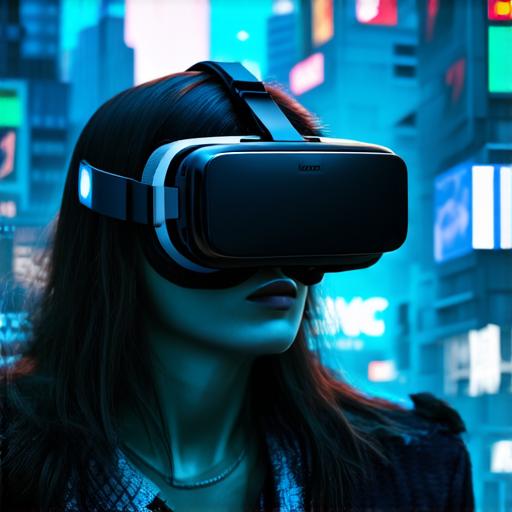Virtual reality technology is rapidly advancing and becoming more immersive and realistic than ever before. From gaming to training simulations, virtual reality is revolutionizing the way we interact with digital environments.
Introduction: The Rise of Virtual Reality
Virtual reality technology has been around for several decades, but it wasn’t until the release of the Oculus VR headset in 2012 that it truly began to take off. Since then, virtual reality has become increasingly popular, with applications in gaming, training, and even healthcare. The immersive nature of virtual reality makes it an incredibly powerful tool for engaging users and providing a realistic experience.
Motion Sickness: The Most Common Danger of Virtual Reality Games
One of the most common dangers associated with virtual reality games is motion sickness. This can be caused by a variety of factors, including the movement of the player or the environment in which they are playing. Motion sickness can range from mild to severe and can be incredibly debilitating for some players. While there is no cure for motion sickness, there are several strategies that can help mitigate its effects.

Eye Strain: Another Common Danger of Virtual Reality Games
Another common danger associated with virtual reality games is eye strain. This can be caused by staring at a virtual environment for extended periods of time without taking breaks. Eye strain can lead to headaches, dry eyes, and even blurry vision. To prevent eye strain, it’s important to take breaks regularly, adjust the brightness and contrast of the virtual environment, and use software that reduces eye fatigue.
Physical Injury: The Most Serious Danger of Virtual Reality Games
The most serious danger associated with virtual reality games is physical injury. While virtual reality technology is designed to be safe, accidents can still happen. For example, players may trip or fall while wearing a virtual reality headset, which could lead to injuries such as concussions or fractures. Additionally, some virtual reality games involve physically interacting with objects in the real world, which could also result in injury.
Case Studies: Virtual Reality Games that Have Posed a Danger to Players
There have been several case studies involving virtual reality games that have posed a danger to players. One such case involved a man who became so engrossed in a virtual reality game that he forgot to eat and drink for 24 hours. This led to severe dehydration and a near-death experience. Another case involved a woman who tripped and fell while wearing a virtual reality headset, resulting in a concussion.
Personal Experiences: My Own Virtual Reality Gaming Experience
As a virtual reality developer, I have had my own gaming experiences with this technology. While I find it incredibly engaging and immersive, I have also experienced motion sickness and eye strain during long gaming sessions. To prevent these issues, I take breaks regularly and adjust the brightness and contrast of the virtual environment to reduce eye fatigue. Additionally, I always make sure to follow safety guidelines when using virtual reality technology, such as wearing protective gear and being aware of my surroundings at all times.
Research: The Impact of Virtual Reality on the Brain
There have been several studies conducted on the impact of virtual reality on the brain. These studies have found that virtual reality can be incredibly effective in treating a variety of conditions, including anxiety, depression, and post-traumatic stress disorder (PTSD). However, there are also concerns about the potential long-term effects of virtual reality on the brain. Some researchers worry that excessive use of virtual reality technology could lead to changes in the structure and function of the brain. While more research is needed to fully understand the impact of virtual reality on the brain, it’s important for players to be aware of these risks and take steps to mitigate them.
Expert Opinions: What Virtual Reality Developers Need to Know
As a virtual reality developer, it’s important to be aware of the potential dangers associated with your technology. While virtual reality can be incredibly engaging and immersive, it can also pose risks to players. To ensure that your games are safe for players, you should follow safety guidelines and conduct thorough testing to identify any potential hazards. Additionally, you should consider incorporating features into your games that help mitigate the risks associated with virtual reality, such as adjustable brightness and contrast settings or breaks between gaming sessions.
Real-Life Examples: The Impact of Virtual Reality on Society
The impact of virtual reality technology has been felt across a variety of industries, from gaming to healthcare. For example, virtual reality is being used in training simulations for pilots, doctors, and emergency responders. It’s also being used in therapy to treat conditions such as anxiety and PTSD. Additionally, virtual reality is being used in the entertainment industry to create immersive experiences for moviegoers and theme park visitors. While the potential benefits of virtual reality technology are numerous, it’s important to be aware of the potential dangers and take steps to mitigate them.
Summary: Virtual Reality Games that Pose a Danger to Players
In conclusion, while virtual reality technology is incredibly engaging and immersive, there are several risks associated with virtual reality games that players need to be aware of. These risks include motion sickness, eye strain, and even physical injury. It’s important for players to take steps to mitigate these risks, such as taking breaks, adjusting the brightness and contrast of the virtual environment, and following safety guidelines when using virtual reality technology. Additionally, it’s important for virtual reality developers to be aware of these risks and take steps to ensure that their games are safe for players. While there may not be a virtual reality game that poses an immediate threat to players’ lives, it’s important to always be cautious when using this technology.
